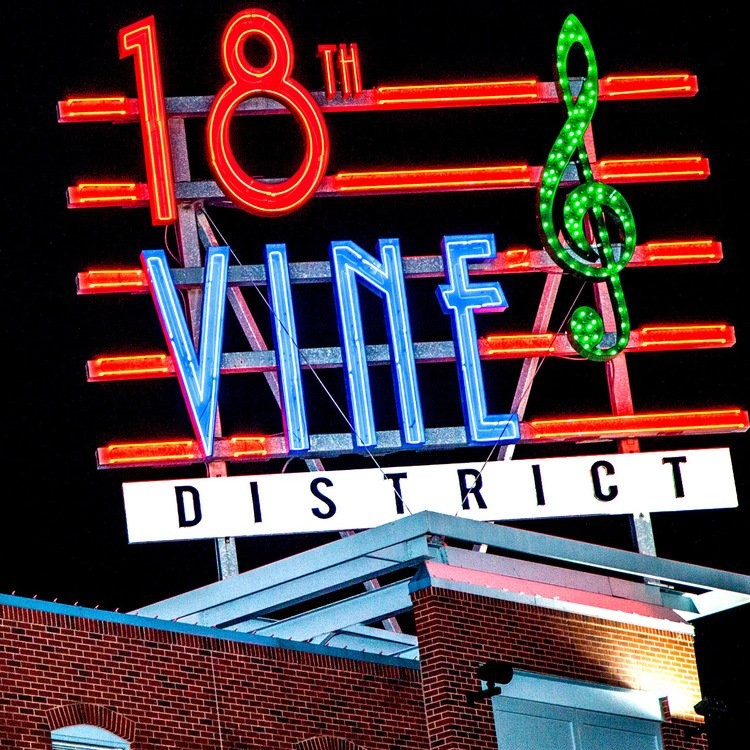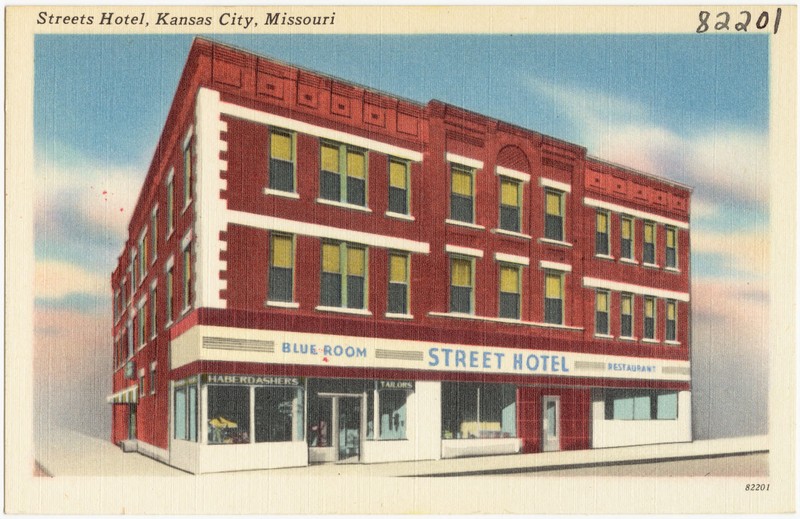Gateway Sign
Introduction
Author-Uploaded Audio
00:00 / 00:00
Introduction to the sign by Michael Patton; recording created by Black Archives of Mid-America
Text-to-speech Audio
In 2010, almost a century after the Jazz Age took off in Kansas City—thanks to the hotels, clubs, and other establishments of neighborhoods like 18th & Vine, which served an African American clientele—this sign was erected on top of a former hotel. The sign was meant to both celebrate and help reinvigorate the area after decades of low investment, and its design harkens back to a time when neon signs would have shone from many of the district's buildings. The 18th & Vine neighborhood, in addition to the clubs, hotels, and restaurants most obviously celebrated by the rollicking sign, was also home to a growing number of Black professionals who built their businesses and careers in a vibrant community within a segregated city.
Images
The distinct gateway sign to the historic 18th & Vine Jazz District

The Street Hotel, known at the time to many as Street's Hotel, was owned by Reuben and Ella Davidson Street. The Blue Room was a major venue in the city's jazz scene.

Backstory and Context
Text-to-speech Audio
The vibrant gateway sign for the 18th & Vine Jazz District sits at the intersection of 18th & Dr. Martin Luther King Jr. Boulevard, atop a three-story building. This building sits where "Street's," named after owners Reuben and Ella Davidson Street, once stood. [1] Street's was for many decades the most luxurious hotel in the city that served African American patrons, but it was razed in the 1980s as part of urban redevelopment projects that destroyed many other historic buildings. [2] The sign itself is a much more recent addition to the neighborhood. Erected in 2010, it celebrates an era when the entire street would have been lit up with neon. With the Pendergast political machine willing to overlook violations of Prohibition, Kansas City's nightlife thrived, with jazz in particular flourishing in the city's clubs.
While the sign's design is "based on the idea that music is the tie that binds people together," the sign also marks the divisions that ran through the Kansas City landscape during the Jazz Age and up to the present. [3] While the clubs, restaurants, and hotels in the 18th & Vine neighborhood would serve African Americans, this wasn't true of businesses in the rest of the city. Though legal segregation was outlawed at the federal level beginning in the 1950s, Kansas City has remained residentially and educationally segregated, with little investment flowing to historically African American neighborhoods like 18th & Vine for many decades. [4] Indeed, many of the architectural and cultural landmarks of the Jazz District were reconstructed or renovated in the 1990s and early 2000s after being razed just several years before.
The sign at 18th & Vine is a celebration of the rich musical and cultural heritage of the city's African American musicians and artists, as well as the vibrant African American community that developed in spite of systemic racism and entrenched institutional segregation. The concentration of theaters, clubs, cabarets, and other venues drew a "veritable 'who's who'" of the jazz world in the 1930s and 1940s: from Jesse Stone to George E. Lee to Mary Lou Williams. [5] The "Colored Musicians Union," now Musicians Local 627, opened in 1917 to challenge unfair labor practices; the union also helped create a unique Kansas City jazz style. [6]
Yet the sign is also, inherently, a reminder of the spatial boundaries that confined African Americans to particular parts of the city, and the lasting effects of this segregation. The sign might now mark a "gateway," but this also implied the existence of a gate—like the many that were so systemically closed to African American residents of Kansas City.
Cite This Entry
University of Central Missouri et. al. "Gateway Sign." Clio: Your Guide to History. May 12, 2023. Accessed March 18, 2025. https://theclio.com/entry/50729
Sources
Footnotes:
- McDonald, Claire and Marissa Baum. The Neon Signs of 18th & Vine, American Jazz Museum. Accessed February 11th 2020. https://americanjazzmuseum.org/content/neon-signs-18th-vine.
- National Register of Historic Places Multiple Property Documentation Form - Historic Resources of the 18th and Vine Area of Kansas City, Missouri, 1991, Section E, Page 6.
- Heritage Consulting Group LLC, “Jazz District Iconic Gateway Sign - Historic 18th & Vine Jazz District”
- Ziegler, Laura. Renewed Focus On Historic 18th And Vine Raises Questions For Residents, National Public Radio - KCUR. May 12th 2016. Accessed February 11th 2020. https://www.kcur.org/post/renewed-focus-historic-18th-and-vine-raises-questions-residents#stream/0.
- Haddix, Chuck. 18th & Vine: Street of Dreams, Club Kaycee. January 1st 1992. Accessed February 12th 2020. https://web.archive.org/web/20080719185522/http://www.umkc.edu/orgs/kcjazz/jazztext/18thvine.htm.
- Kansas City Jazz, Musicians Local 627 and the Mutual Musicians Foundation: The Cradle of Kansas City Jazz. January 1st 2003. Accessed February 12th 2020. https://library.umkc.edu/spec-col/local627/text/introduction/index.htm.
Additional Sources:
- Jazz District Iconic Gateway Sign – Historic 18th & Vine Jazz District. Heritage Preservation Group. Accessed November 27, 2017. http://heritagepreservationgroup.com/portofolio/jazz-district-iconic-gateway-sign-historic-18th-vine.
- Jazz District History. Accessed November 27, 2017. http://www.kcjazzdistrict.org/about/history/.
- Gateway Sign Photo. South Austin Gallery. web. Accessed 11/29/2017. http://www.southaustingallery.com/shopkansascity/copy-of-name-number
https://www.digitalcommonwealth.org/search/commonwealth:xs55md280

